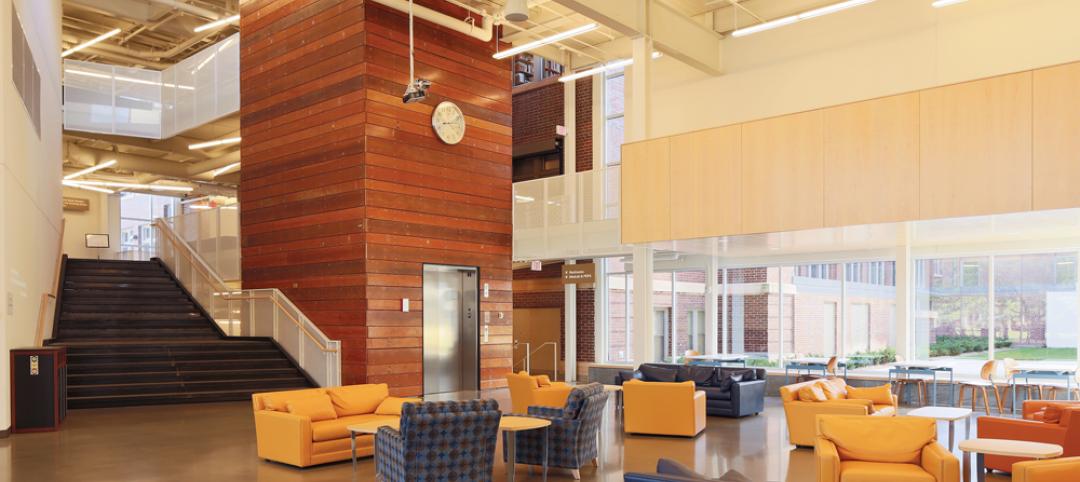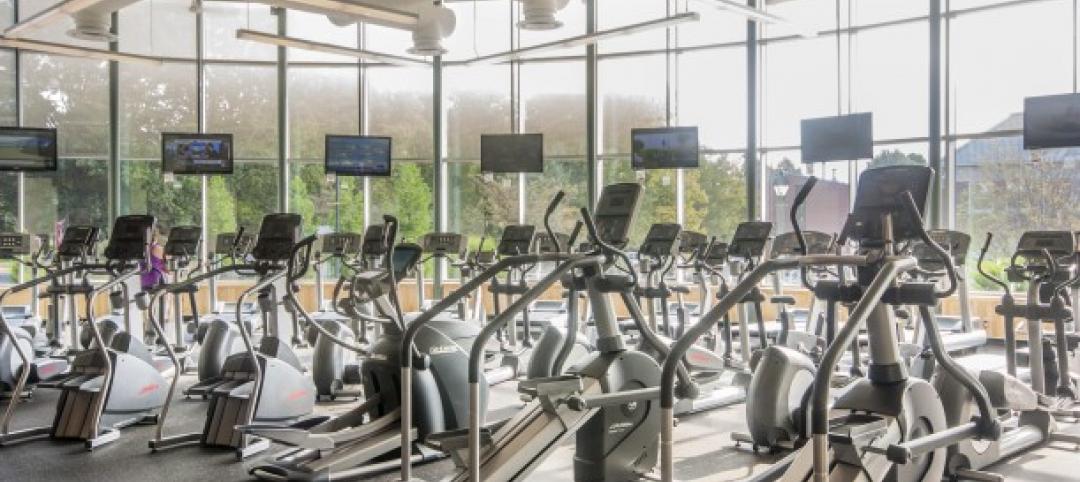The small, triangular speck of land — a brownfield site once occupied by a gas station — barely measured 7,500 sf and hardly seemed suitable for building much of anything, let alone a 49,700-sf academic and administrative center. However, its location in Boston's prestigious Longwood Medical Area, with an address on Huntington Avenue—known as the city's Avenue of the Arts —made it impossible for the Massachusetts College of Pharmacy and Health Sciences to pass up the unwieldy property. By early 2007, it was clear that the MCPHS's Boston campus was quickly outgrowing its current digs in the heart of the densely populated and land-scarce medical district. Hoping to build a modern new facility within walking distance of its main campus, MCPHS administrators jumped at the chance to develop the compact parcel.
Teaming with Perkins+Will for their fourth project together, MCPHS worked with the architects to create an infill plan that addressed the school's need for additional space. At the same time, the plan had to meet the concerns of the adjacent residential community — the Mission Hill Triangle Historic District, an old neighborhood full of Victorian brownstones and single-family homes and active, vocal residents. Huntington Avenue serves as the boundary between the two, with the Richard E. Griffin Academic Center at ground zero and forced to meet the needs of two very different communities.
The Mission Hill community had long been wary of new development encroaching on their neighborhood, and they'd been burned by urban renewal efforts in the past, including construction of public housing apartment towers — some 20 stories tall — in the middle of their neighborhood. Taking their concerns to heart, MCPHS made the neighbors part of the Building Team and invited them (and other stakeholders) to regular design meetings.
Gerald Autler, senior project manager and planner with the Boston Redevelopment Authority, credits the school's decision to include its neighbors early in the planning process with diffusing what could have been a contentious situation. Autler points to the Building Team's request for additional height as something that "could have been an explosive issue." Instead, with the community a part of the decision-making process, the bid for extra height won their support. "The process went as smoothly as any I have ever been involved in," says Autler.
Even with the extra height, the building still rises only six stories above ground (with two additional below-ground levels) and matches the scale of its residential neighbors. A brick facade adds a traditional Bostonian touch, while abundant glazing and a glass street-level lobby inject contemporary elements expected of an urban, modern educational facility focused on the health sciences. The Perkins+Will designers also made sure to mask the service and equipment acess on the side of the building facing the neighborhood, to minimize any perception of that facade as being the"service area."
A Revit BIM model aided the project's fast-track design and construction schedule and allowed the Building Team, including general contractor Bond Brothers, Inc., to simultaneously produce renderings and construction documents for concurrent city and client approval and to issue early bid packages for earthwork, concrete foundations, steel, and mechanical systems in timely fashion. To remediate the brownfield site (which also abuts a transit line), most of the soil had to be abated on site and trucked away because there was no place to store excavated materials. With minimal staging and laydown space, delivery and storage of materials was another nightmare. The Building Team utilized sidewalks and just-in-time delivery and worked closely with the Boston Transportation Department to coordinate deliveries.
Despite the tight squeeze, a nearly fifty-thousand-square-foot facility was successfully shoehorned into the remnant property, housing the college's School of Nursing, School of Physician Assistant Studies, Office of Institutional Advancement, and Office of College Relations. The six-story center contains a technology center, student commons, classrooms, patient assessment and clinical simulation teaching labs, and faculty offices.
A 230-seat auditorium — which required a 30-foot-deep excavation — sits below-grade, while a multifunction conference space (which is available for use by the community) occupies the top floor and offers unobstructed views of the Boston skyline.
In honoring the Richard E. Griffin Academic Center with a Silver Award, the jury members were impressed with the Building Team's community outreach and its ability to overcome unusually difficult site constraints.
PROJECT SUMMARY
Silver Award
The Richard E. Griffin Academic Center,
Massachusetts College of Pharmacy and Health Sciences
Boston, Mass.
Building Team
Submitting firm: Perkins+Will (architect)
Owner: Massachusetts College of Pharmacy and Health Sciences
Interior designer: Kristine Stoller Interior Design
Structural engineer: Souza True Partners
MEP engineer: RDK Engineers
General contractor: Bond Brothers, Inc.
General Information
Project size: 49,700 sf
Construction cost: Confidential, at client’s request
Construction time: August 2007 to January 2009
Delivery method: CM at risk
Related Stories
| Nov 25, 2013
Building Teams need to help owners avoid 'operational stray'
"Operational stray" occurs when a building’s MEP systems don’t work the way they should. Even the most well-designed and constructed building can stray from perfection—and that can cost the owner a ton in unnecessary utility costs. But help is on the way.
| Nov 19, 2013
Top 10 green building products for 2014
Assa Abloy's power-over-ethernet access-control locks and Schüco's retrofit façade system are among the products to make BuildingGreen Inc.'s annual Top-10 Green Building Products list.
| Nov 18, 2013
ASSA ABLOY, CertainTeed team up to tackle classroom acoustics
The new alliance has uncovered easily accessible solutions to address these acoustical challenges and reduce the sound reverberation that further complicates noise issues.
| Nov 15, 2013
Greenbuild 2013 Report - BD+C Exclusive
The BD+C editorial team brings you this special report on the latest green building trends across nine key market sectors.
| Nov 15, 2013
Halls of ivy keep getting greener and greener
Academic institutions have been testing the limits of energy-conserving technologies, devising new ways to pay for sustainability extras, and extending sustainability to the whole campus.
| Nov 13, 2013
Installed capacity of geothermal heat pumps to grow by 150% by 2020, says study
The worldwide installed capacity of GHP systems will reach 127.4 gigawatts-thermal over the next seven years, growth of nearly 150%, according to a recent report from Navigant Research.
| Nov 8, 2013
S+T buildings embrace 'no excuses' approach to green labs
Some science-design experts once believed high levels of sustainability would be possible only for low-intensity labs in temperate zones. But recent projects prove otherwise.
| Nov 8, 2013
Walkable solar pavement debuts at George Washington University
George Washington University worked with supplier Onyx Solar to design and install 100 sf of walkable solar pavement at its Virginia Science and Technology Campus in Ashburn, Va.
| Nov 7, 2013
Fitness center design: What do higher-ed students want?
Campus fitness centers are taking their place alongside student centers, science centers, and libraries as hallmark components of a student-life experience. Here are some tips for identifying the ideal design features for your next higher-ed fitness center project.
| Nov 5, 2013
Net-zero movement gaining traction in U.S. schools market
As more net-zero energy schools come online, school officials are asking: Is NZE a more logical approach for school districts than holistic green buildings?
















